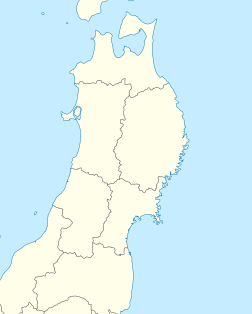Mount Chōkai
| Mount Chōkai | |
|---|---|
| 鳥海山 | |
Ultra | |
| Coordinates | 39°05′57″N 140°02′56″E / 39.09917°N 140.04889°E[1] |
| Geography | |
| Location | Yamagata and Akita, Tōhoku, Japan |
| Geology | |
| Mountain type | Stratovolcano |
| Last eruption | March to April 1974 |
Mount Chōkai (鳥海山, Chōkai-san or Chōkai-zan) is an active volcano located on the southern border of
Outline
Mount Chōkai is a complex stratovolcano made of two old and new newer volcanoes, composed primarily of basalt or andesite.
Mount Chōkai is shared by two municipalities in Akita Prefecture and four municipalities Yamagata Prefecture; however, its peak is located in
On the south side of the mountain is “Kokoro Yukikei,” where snow remains in the shape of the kanji for “heart” in even in summer, and portions of the summit have perennial snow, and geological evidence of glaciation in the recent past.
Indigenous species of Mount Chōkai include the butterfly thistle and butterfly fish.
Eruptions
Mount Chōkai is a very active mountain. Known major eruptions occurred:
- 466 B.C. Causes massive collapse of mountain peak (based on dendrochronology)
- 810 AD Records of eruption continue to 824.
- 840 AD Eruption.
- 871 AD Eruption and lava flow with Volcanic explosion index: VEI 2
- 939 AD Eruption
- 1560 AD Eruption
- 1659-1663 AD Eruptions
- 1740-1741 AD Eruption
- 1800-1801 AD Steam explosion, lava flow, formation of a new lava dome: Eight people killed
- 1821 Eruption recorded.
- 1834 AD Eruption
- 1971 AD Eruption
- 1974 AD Steam explosion, small mud flow; Volcanic Explosion Index: VEI 1
History
Mount Chōkai has been the object of mountain worship since ancient times. From the Heian period, it gradually became a training ground for Shugendō, as an avatar of Yakushi Nyorai. From the south was a pilgrimage path to the summit. In the middle of the Edo period the mountain drew many pilgrims and had 33 chapels at its base., with additional routes to its summit opened in the north. There is also a tradition that the island of Tobishima in the Sea of Japan was originally a part of the summit of Mount Chokai.
Three ships have been named after Mount Chōkai:
-
Chōkai volcano
-
Ridge of the Mt. Chokai
-
Lake Chokai
-
Lava dome on the summit
See also
References
- ^ a b c "Japan Ultra-Prominences". Peaklist.org. Retrieved 2015-01-01.
- ^ "鳥海山登山ガイド". Mt. Chokai WEB. Retrieved 13 January 2014.
- ^ Mount Chōkai&Tobishima Geopark
External links
- Chokaisan - Japan Meteorological Agency (in Japanese)
- "Chokaisan: National catalogue of the active volcanoes in Japan" (PDF). - Japan Meteorological Agency
- Chokaisan - Smithsonian Institution: Global Volcanism Program
- Tohoku Tourism home page
- https://www.thehiddenjapan.com/mtchokai - English Information





